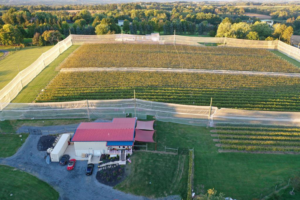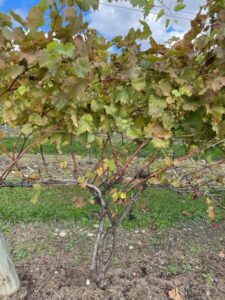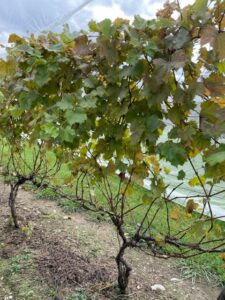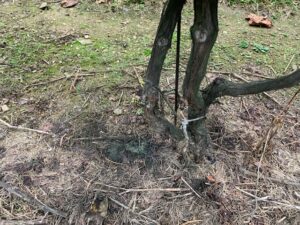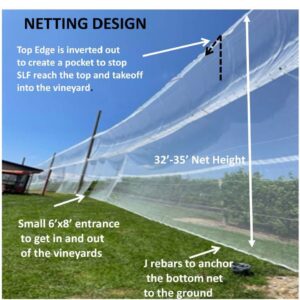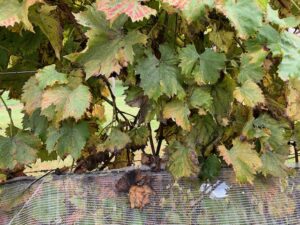Final report for FNE21-993
Project Information
Purpose:
The project investigated a non-pesticide approach to control Spotted Lanternfly (SLF) invasion of vineyards.
Method:
- The approach was to build a physical barrier of insect netting around a vineyard to stop SLF's continuous migration from the neighboring trees between August and October.
- Since SLF is a hopper and doesn't fly too high, expectation was that the netting will stop the continuous influx of SLF from the neighboring trees.
- A 32'-35' high insect netting was erected around a 4 acre vineyard keeping some grape vines outside the nets as negative controls.
- Data collection started a year ahead of the project on the quantitative SLF presence markers in the vineyard (blackening of leaves, blackening of cordons and vine trunks, egg masses, and SLF physical presence during active adult phase between August-October).
Results:
- Data collected and compared between the two year; year before (Pre-netting-control) and during the experimental year indicated that physical barrier significantly prevented the migration of SLF from neighboring tree.
- Several markers of SLF presence were assessed (blackening of leaves, trunks, cordons, presence of egg masses) and showed quantitative difference between the two years as well as between the experimental vines (inside the nets) and control the control vines (outside the nets) groups showing that the physical barrier works preventing the invasion of SLF into the vineyard.
- An observation on the physical presence of live SLF as counted and compared between the two years and between the experimental and control groups unequivocally proven that physical barrier was effective.
- Though the technique is very effective, its cost was prohibitive. Perhaps, further engineering to have a permanent installation of nets for multi year use may help reduce the net cost per year basis.
Outreach :
- An information program was organized between the Investigator, Northampton County Conservation District and PA and Penn State University Extension Service (Dr. Korman) on May 28th, 2022 and presented during two sessions held at M&M Vineyards (11am-Noon and 2pm-3pm) to inform and share data with public/farmers/other attendees. This program announcement was made on social media.
- The program results were shared with local farmers and local vineyard owners. SLF-Training-Program
The proposal seeks to address if a physical barrier would intercept adult SLF migration from the surrounding landscape into our vineyard. Following are the key methods to assess efficacy of the treatment:
- In early spring 2021, the number of egg masses per vine will be counted (reflecting 2020 SLF presence) and this will serve as a baseline for year 2022 egg masses counts (reflecting 2021 presence).
- The amount of sooty mold on leaves will be recorded on the vines both within and outside of the barrier. similar data during 2020 growing season were collected and will serve as baseline for the intensity of SLF presence in the vineyard in 2021.
- The number of dead SLF at the base of the netting wall will be counted regularly. This will provide a metric of how many SLF have been prevented from entering the vineyard. (This objective could not be completed for lack of any SLF counts on the outside of the nets perhaps due to high winds at the site).*
- The number of SLF per vine in the untreated (no barrier) and treated (protected with barrier) areas will be counted throughout the season to assess effectiveness of the barrier.
If successful, this method provides a practical, economical and perhaps the only sustainable agriculture solution currently to prevent SLF damage in vineyards of all sizes.
Spotted lanternfly (SLF), Lycoma delicatula is an invasive insect native to Asia, first discovered in PA in 2014 in Berks County and has now spread to 9 eastern states with additional detections in 5 additional states (attached photos, adult SLF and lifecycle ). SLF falls in Hemipteran insects, meaning it has a piercing-sucking mouthpart, allowing them to drill into phloem of plant to feed directly on sap. SLF has a broad host range feeding on 70+ plant species, including tree-of-heaven, grape, black walnut, red/silver maple, river birch and sumac (4). Major damages are being noted in vineyards in the northeast region as captured by Paul Vigna (1, see attached, adult SLFs on a grape vine). Feeding damage caused by SLF includes reduced photosynthesis, sap flow, fruit quality, and winter hardiness of the grapevine (H. Leach, personal communication). As SLF feeds, it excretes honeydew, a sugary waste product which can build up on the leaves and cause the growth of sooty mold (attached photo of a grape leaf). This mold acts as a sunblock and can prevent photosynthesis, thereby reducing the energy available for the grapevine. SLF has the potential to greatly impact agriculture, if uncontrolled; this insect could cost the PA state alone $324 million annually and more than 2800 jobs. Many vineyards in eastern PA have incurred substantial vine death and there is no clear long term sustainable solution to curb this pest (1). PA State Governor and USDA (SCRI CAPS Grant) have allocated $18 million in grants recently for research on SLF that affects the future vitality of the states agriculture industry. Key efforts included in this funding are: quantify impact on at-risk-specialty crops including grapes, conduct fundamental research on pest’s basic biology, ecology, and behavior, develop biological controls contributing to long-term sustainable solutions; deliver management solutions to specialty-crop stakeholders. While research progress has been made on SLF, grape growers are still left with few control techniques apart from the repeated use of insecticides to manage SLF on their farms.
M&M vineyards encountered a major population of SLF in 2020 and in spite of insecticidal sprays; the SLF’s were difficult to control as new populations continuously moved in from the surrounding landscape. In 2020, a small scale study was conducted at Penn State using a 13’ tall insect net wall on one side of a vineyard, covering in netting treated with insecticide (Heather Leach, personal communication, 4). This structure showed promise, reducing SLF populations on the nearby vines by 40.4% throughout the growing season. However, additional height and length was noted as ways to improve efficacy of this technique in the future.
We are proposing to erect a 40’ tall insect net fence around the vineyard on four sides. The top side of the net would be inverted to the outside to create an inverted V arm (2’ long) to create an upside down pocket at the top of the net for SLF to gather after walking up the net. Netting treated with insecticide (long lasting insecticide net, LLIN) will be added to this inverted V pocket at the top in select areas. A small number of vineyards rows (~10%) will be kept outside the nets as negative controls to determine the efficacy of the barrier. SLF studies have shown (personal communication-Heather Leach and Dr. Rajotte, Penn State) that SLF tends to walk upward to reach the top of any object to take the next flight (if it didn’t land on a desirable host tree). Once SLF reaches the top inside of the inverted V section of the net, it will come in contact with the insecticidal netting and die before reaching the vineyard. The number of dead SLF at the base of the wall will also be recorded regularly throughout the growing season.
Most state and federal grants funded are looking for a long-term solutions to the problem, an important goal for overall control of this invasive species. However, grape growers are left with only one effective solution at present: repeated insecticide applications. Frequent use of these broad-spectrum insecticides is not economically or environmentally sustainable and can cause other issues, including killing beneficial insects and flaring secondary pests. SLF is a serious pest of grapevines causing plant health and yield declines, and new management tactics are desperately needed in vineyards to effectively control this pest. This proposed measure could both decrease the use of insecticide applications in vineyards and the number of SLF in the vineyard and suggests a promising new tactic for SLF management in vineyards.
M&M Vineyards was established about 10 years ago and opened its tasting room in November, 2017. We produce ~20 tons of grapes on 4 acres per year and we only use our own grapes to make our wines (true local). All wines are sold onsite at the winery and surplus grapes sold to local wineries. Our annual gross revenues are ~$100K-$125K. All farm resources were applied to the project (employees, equipment etc.). A supplemental funding of $5K was provided by Northampton County Conservation District on a similar project on the education of public to SLF infestation.
Cooperators
- (Educator)
- - Technical Advisor
- - Technical Advisor
Research
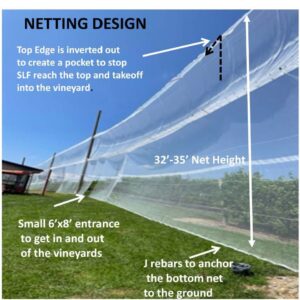
The plan includes erecting 40’ high insect net around the vineyard (2000’ total length). See attached photo of the treated or inside the netting vine rows and untreated or outside the net vine rows. 52’ long utility poles will be buried 7’ deep in the ground at the periphery of the vineyard 100’ apart. Multiple high tensile strength, 12.5 gauge steel trellis wires will be installed on the poles to hang 17’ wide insect nets with overlapping ends tied to the trellis wires. Top end of the curtain will have an inverted V design to the outside. Two of the four sides will have insecticidal netting (30” wide) running across the length.
- Egg masses number per vine comparison in year 2022 among inside (positive control) and outside (negative control) vines will provide the direct evidence of the effectiveness of the netting.
- We have collected baseline data on severity of sooty mold on grapevines in 2020 season per vine for 10 vines as in #1 above monthly for August, September and October. The date on sooty molded leaves included coding of 1-5 with 1 being minimum deposit (10 spots or less) and 5 being fully blackened leaves. Similar data will be collected per vine in 2021 during August to October post net installation to measure intensity of SLF presence. Similar observations will also be made within positive and negative vines within the same year giving direct evidence of the effectiveness of the netting.
- Direct count of live SLF present for both the positive and negative controls within the same year will be made by selecting 10 vines for 4 rows on the outside (negative control) and 4 adjoining rows on the inside to have direct comparison. SLF are easy to identify compared to other vineyard pests and all vineyard staff are trained on the identification of SLF.
- The number of dead SLF at the base of the netting wall will be made on all four sides. Two 25’ sections will be marked on each side and all dead flies will be collected and counted weekly between August and October. This may provide evidence on; 1) how effective the netting is at stopping SLF entry, 2) how effective are insecticidal nets. Comparison will also be made on the four sides to assess the SLF pressure from the tree lines (north and south) verses agriculture fields (east and west).
- All data collection will be made by MS (project lead) with the assistance of vineyard staff and project technical support (Heather Leach, Penn State). Ms. Leach will also assist with statistical analysis, comparing the number of SLF on treated vines to the untreated vines using an ANOVA with repeated measures.
- The cost of the project will be carefully monitored, including supplies, construction time, and labor estimates. This will be used to help build an economic assessment of the project and allow other growers to evaluate its efficacy both in controlling SLF and its economic feasibility. This information will be shared with other growers from Heather Leach, technical support on the project.
The project started in the spring of 2021 initiating baseline data collection reflecting the presence of spotted lanternfly (Blackening of leaves and trunks/cordons and presence of egg masses) in the vineyard during the year 2020 (see Table 1 below) . Three attributes of the SLF presence counted, Vine Trunk/Cordon blackening, Egg masses on vines and leaf blackening due to SLF presence and their sugary excretion consequently leading to sooty mold growth blackening vine parts. Data were also collected in the Fall of 2020 counting live SLF on select number of vines per row (Table 1). The installation of netting around the vineyard was completed early August -2021  . During the months of September and October, 2021, additional data were collected on the control vines which resided outside the nets (Vine Rows 44-48) as well as on the experimental vines which were inside the nets (Vine Rows, 1-43) (Table 1). Additional data collected in the spring of 2022 (egg masses).
. During the months of September and October, 2021, additional data were collected on the control vines which resided outside the nets (Vine Rows 44-48) as well as on the experimental vines which were inside the nets (Vine Rows, 1-43) (Table 1). Additional data collected in the spring of 2022 (egg masses).
The data analyses clearly indicate reduced SLF presence inside the netted area and showing a net advantage of the physical barrier preventing mass migration of SLF into the vineyard from the neighboring trees. Data points were only collected only once in the year (rather than proposed monthly August to October for lack of labor force during COVID pandemic years 2020 and 2021). Additionally, we did not find any dead SLF outside the nets including under where insecticide impregnated nettings. This might have been due ineffectiveness and/or of the insecticide impregnated nets and/or heavy winds often observed at the vineyard blown away any dead SLF from under the outside the nets. No data on dead SLF were thus reported.
The data analysis on the trunk/cordon blackening (see table below and Fig. 3) note an aggregate score of 400 in YR2021 (pre-net) vs 179 in YR2022 (post net) in the experimental group (this is an aggregate count on 430 vines, 10 vines counted per row and 43 rows in total in the experimental group) and 45 and 16 respectively for the YR2021 and YR2022 in the control group (this is aggregate count on 50 vines, 10 vines counted per row and 5 control rows ). The comparison on the trunk/cordon blackening was more relevant between the two years among the experimental group since the net structural difference in the canopy style of the two vine groups. Experimental vines were all Vertical Shoot Position canopies (vine cordons at the bottom and shoots and leaves growing vertically above cordons with likely SLF excretions falling on the cordons) and control vines were all Double Geneva Curtain (cordons on the top and the branches and the leaves droop down with less likelihood of SLF excretions falling on cordons but instead fall on leaves, branches or on the ground). Data depicts a net reduction in cordon blackening between year 2020 and 2021 (aggregate scores of 400 and 179 respectively). Also, point to be noted that that same 10 vines per row were counted in the two years and cordon blackening from year 2020 didn't get fully washed with rain by the year 2021. So the year 2021 experimental data may have some residual darkening of cordons from year 2020 (See Fig. 1 and 2 for residual blacking without SLF presence). Overall, the data from the year 2020 and 2021 indicate reduction in SLF presence in the year 2021. No insecticide sprays were used in 2021.
Leaf Blackening (Fig. 5) is a consequence of continuous sugary excretions on the leaf surfaces in the current year (as the leaves are shed end of the year and new leaves emerge next spring so no skewing of previous years blackening can impact unlike with cordons which are kept year to year) by the SLF. A remarkable difference noted in the year 2020 and 2021 (Aggregate score of 169 and 0 for the two years). The data represent 10 vines in rows, 33-43 in the experimental group and rows 44 to 48 in the control groups (especially since vines in rows 33-43 are more intense green and leafy structure and attracted more SLF than the other grape vine varieties. No leaf blackening was noted in year 2021 perhaps depicting very little SLF if any present in rows 33-43 and the control group showed leaf blackening in both years albeit lesser in 2021 compared to the year 2020. These data also reflected as if there is a certain threshold of SLF count presence before leaf blackening starts and in year 2021 that threshold was not reached. Overall the data indicate net benefit of a physical barrier controlling net migration of SLF in the vineyard. No insecticide sprays were used in 2021.
Egg masses were counted manually as well as using SLF egg mass sniffing dogs provided by Cornell University (Video 1). Egg mass count reflects net presence of the SLF in the year. For the experimental group, for the years 2020 and 2021 the aggregate count noted as 394 and 154 (430 vines counted each year). This compared to the control group showing net aggregate count of 7 and 18 for the years 2020 and 2021 (50 vines counted). There were fewer egg masses noted in the 2021 in the experimental group depicting lesser SLF presence. Since same grape vines were counted in the two years (egg masses were counted in the spring on permanent structures of cordons and trunks only, after the majority of branched were pruned), there's slight chance of counting/.recounting of unhatched or partially hatched egg masses from the previous year into 2021 count. Still, the overall count, clearly indicated less SLF presence in the year 2021. No insecticide sprays were used in 2021.
SLF presence was a clear indication of the net impact of the physical barrier on SLF migration. The SLF presence aggregate count for 430 vines in the year 2020 and 2021 were 1463 and 6 respectively. This was a remarkable contrast clearly showing the prevention of SLF migration with a physical barrier. The control group showed aggregate count of 415 and 172 SLF presence in year 2020 and 2021 (on 50 vines). No insecticide sprays were used in 2021.
The pregame was set out to assess if invasion of SLF into the vineyards could be prevented by 35' high physical barrier around the vineyard (insect nets) rather than use of insecticides.
Data collected and compared between the two year, i.e., the year before (Pre-netting-control) and during the experimental year indicated that physical barrier significantly prevented the migration of SLF from neighboring tree. Several markers of SLF presence were assessed (blackening of leaves, trunks, cordons, presence of egg masses) and showed quantitative difference between the two years as well as between the experimental vines (inside the nets) and control the control vines (outside the nets) groups showing that the physical barrier works preventing the invasion of SLF into the vineyard. also, observations on the physical presence of live SLF as counted and compared between the two years and between the experimental and control groups unequivocally proven that physical barrier was effective.
Though the technique is very effective, it was found to be cost was prohibitive. Perhaps, further engineering to have a permanent installation of nets for multi year use may help reduce the net cost per year basis.
Education & Outreach Activities and Participation Summary
Participation Summary:
- An information program was organized between the Investigator, Northampton County Conservation District and PA and Penn State University Extension Service (Dr. Korman) on May 28th, 2022 and presented during two sessions held at M&M Vineyards (11am-Noon and 2pm-3pm) to inform and share data with public/farmers/other attendees. This program announcement was made on social media.
- The program results were shared with local farmers and local vineyard owners. SLF-Training-Program
Learning Outcomes
SLF has caused major damage to the vineyards in the northeast PA. The pest has spread to more than 14 states in the USA.
This was a unique program to evaluate non-pesticide approaches to control SLF infestation of the vineyards.
Even though, one may eradicate resident nymphs or adult SLFs in the vineyard, continue influx of new SLF from the neighboring trees is an end less process from August-October. Eradication of SLF in the trees is an enormous under taking perhaps not possible due to continuous move and migration of SLF in the tree canopies.
Controlling SLF with a physical barriers is possible and is a sustainable and conservative agriculture practice.
No other conservative methods (other than the use of insecticides) yet developed to prevent crops and no natural predator for SLF exists.
SLF can cause major revenue losses including loss of jobs.
Project Outcomes
This was a significant undertaking for a small vineyard and since this was executed during Pandemic COVID time (2020. 2021), it imposed serious constraints on the labor availability, contractors availability and the staggering costs when net revenues for the business plummeted.
The project was successfully completed with a clear goal in mind that if a physical barrier could prevent the migration/invasion of SLF into the vineyards from the neighboring trees. It provided significant understanding on how SLF impacts grapevines and SLF's general behaviors/practices as well as the control practices to prevent crops from them.
Though project clearly showed that a physical barrier can clearly prevent the SLF invasion; the cost effectiveness of the project was prohibitive. Perhaps further engineering to design similar physical barriers for multiple year use between August-October each year may prove more practical.
This was the only project requiring no pesticides to intervene SLF infestation and was successfully completed clearly showing the net benefits.
This was a significant undertaking for a small vineyard and since this was executed during Pandemic COVID time (2020. 2021), it imposed serious constraints on the labor availability, contractors availability and the staggering costs when net revenues for the business plummeted.
The project was successfully completed with a clear goal in mind that if a physical barrier could prevent the migration/invasion of SLF into the vineyards from the neighboring trees. It provided significant understanding on how SLF impacts grapevines and SLF's general behaviors/practices as well as the control practices to prevent crops from them.
Though project clearly showed that a physical barrier can clearly prevent the SLF invasion; the cost effectiveness of the project was prohibitive. Perhaps further engineering to design similar physical barriers for multiple year use between August-October each year may prove more practical.
This was the only project requiring no pesticides use to intervene SLF infestation and was successfully completed clearly showing the benefits. Northeast states in the country are facing the SLF infestation in the vineyards and thus could benefit from the principals used here. Overhead netting on smaller vineyards could also benefit if costs could be controlled. Over the row nets can show similar benefits but unfortunately, they also limit the sunshine into the vine thus compromising the quality of grapes. As noted above further design changes allowing multiple year use of the nets erected would be more practical for cost perspective.
